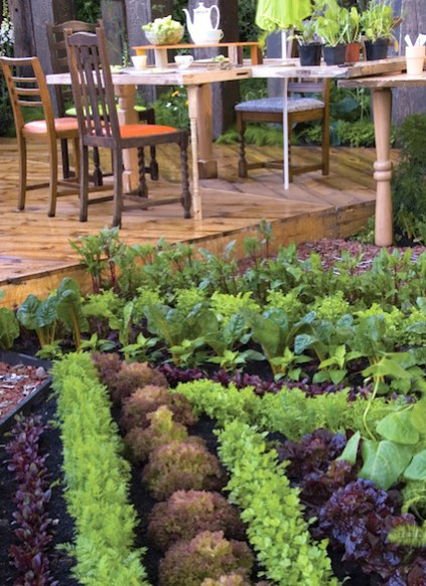
City life can be hectic.
You’re running around all day. You get up early and catch the train to work. You spend a long busy day at the office. And back to your apartment when it’s all done.
You want to have some moment of peace. You’ve heard that gardening is a way to reach that.
But what can you do with the limited space you live in? Is there a way to grow plants that you enjoy? Will the city life suit your plants and not kill them?
The good news is there is a way to grow most plants you want in the comfort of your home. This method of growing is known as urban gardening.
What Is Urban Gardening?
It’s hard to find growing space in urban areas.
But that’s the problem urban gardening tries to solve. It aims to use accessible places in your house or apartment and get you growing.
You could be growing your own food in balconies, rooftops, alleyways, or sidewalks.
This does encounter difficult conditions like polluted soil. Or soil filled with sand or clay. Situations like noisy or windy places that affect the plants.
But that’s where you need to be creative and experiment. That’s where the magic of urban gardening can help you.
How Much Space Do You Have?
The first thing you should check if what space you’re working with.
You could be growing your garden in the balcony, fire escape, desk, windowsill, closet, bookshelf, patio, or railing. The possibilities are endless if you put your mind to it.
If you’re going to grow in the balcony, will it take the weight of the plants? Can you place heavy pots without collapsing it?
You could be innovative and use a “false” floor on your rooftop. This will be tailored to grow plants without leaking water or damaging your roof.
You can make good use of your urban home space by using vertical gardening. This helps grow plants vertically instead of taking a lot of horizontal growing space.
How Much Light Is Available?
It’s important to grow the type of plants that are suitable for your growing space. Some plants need more sunlight than others and you need to consider this fact.
You should spend a day looking at the path of the sun. Check this every 2 hours to know which spots get how much sunlight.
There are many plants that do well with at least 6 hours of sunlight. But you might not have that much sun available in your apartment. Maybe your apartment is blocked by partitions, other buildings, or walls.
But no worries, there are several plants that don’t need as much sun to grow well. The plants can be divided into full-sun, part-sun, or shade-loving.
The full-sun plants are those that need at least 6 hours of sunlight every day. These are fruit-bearing plants like tomatoes, chilies, peppers, and beans.
The part-sun plants are those satisfied with 4 to 6 hours of sunlight every day. These could be greens like lettuce, spinach, coriander.
The shade-loving plants are those that grow well in shade and don’t do well in too much sun. They need less than 4 hours of sunlight every day. These include plants like carrots and leafy vegetables.
You could choose to grow plants in containers that could be moved around on wheels. This helps you get them the right amount of sunlight they need.
What Type Of Gardening Is Suitable For You?
If you’ve limited space in the apartment, there’s a couple of methods you can use or a combination of them.
Container gardening is the obvious choice because you can place the containers in your balcony, patio, windowsill. You could even place them indoors on the desk, bookshelf, closet.Another way to save up gardening space is to use vertical gardening. Here you grow plants vertically so they take up less space. You could even have hanging planters so the vines can fall over and grow vertical.
What Type Of Containers Can You Use For Gardening?
With container gardening, you have plenty of choices for the containers you use. These could be made from plastic, metal, ceramic, or terracotta.
The size of the container affects the type of plant you can grow in it. A large container is good because it means more soil, more water, and more nutrients.The depth of the container should be 8 to 12 inches to give a good growing area for the roots and retain sufficient nutrients and moisture. If the moisture is not sufficient, the plants will dry out and die.
You do need to be careful about the weight and durability of the container you choose. It should be good enough to hold in your apartment without damaging it.
One option is to use grow bags instead of a container. They are inexpensive, lightweight, and reusable. You could even recycle containers like paint cans, bins, boxes, and buckets as containers.
You need to be careful when using porous pots like terracotta because they lose moisture fast. Instead, you can place a plastic pot inside and grow the plant in it.
If you don’t have the time to water the plants every day, you may choose a self-watering container. These can hold water for a few days so the plants have it available when they need it.
Whatever container you choose, make sure there are drainage holes at the bottom. This helps prevent the roots from drowning and suffering from rot.
If the plant is a vine on a trellis, ensure the container is heavy and does not topple over. Or you can secure the trellis to a railing.
How To Choose Soil For Your Urban Garden
Even if you have a small garden near your apartment, the soil might not be good. Urban soil can be polluted with chemicals. Or it could lack nutrients containing lots of sand or clay.
It could also contain pests and diseases that would be harmful to the plants. That’s why it’s not advisable to use the soil from your garden in containers.
The best soil you can use for your urban garden is a good potting mix. This should give good aeration and retain enough moisture while draining out the excess. And it should contain the required nutrients for growing plants.
Make sure that the potting mix you use is free from chemicals and made from organic sources.
What Food Can You Grow With Urban Gardening?
If you’re beginning with urban gardening, it’s best to start easy. A few simple herbs in a shady spot will get you started. Growing fruit-bearing plants like tomatoes and chilies might be a little more work.
If you don’t have the time to start the plants from seeds, you can get some seedlings from a garden center. Just make sure they’re organic, healthy and suitable for your garden.
It’s nice to grow plants with similar needs together. This could be herbs like basil, cilantro that need more water and sun. Or herbs like sage and oregano that need lesses water and sunlight.
If you’ve a place with partial sunlight, you can grow greens like lettuce, arugula, and spinach. Some varieties of tomatoes like cherry tomatoes and chili peppers can also grow in such places.
The type of plants you want to grow should also depend on your needs. If you enjoy eating some vegetables, you can try growing them.
Root vegetables are a one-time harvest so make sure you’re ready for them. Large vegetables like pumpkin need larger spaces and may crowd out other plants.
You have options of fruit-bearing plants like tomatoes, chilis, zucchini, eggplant, and beans.
Some other options include chives, lettuce, radish, basil, coriander, carrot, cucumber, spinach, parsley, beet, okra, potatoes and summer squash.
As you can see, you can grow almost any vegetable you want with your urban gardening.
How To Water Your Urban Garden
Watering plants can be tricky because you may either overwater or underwater them. And the symptoms for both situations may be the same.
The leaves may start to yellow because either the lack of water means lack of nutrients. Or because the roots are rotting, there’s a lack of nutrients.It’s important to have good drainage near the bottom of the containers. You can do this by putting some gravel at the bottom of the container and then adding the potting soil.
Vegetable plants need a lot of water and you need to water they every day. If you don’t, the plants will have poor development. They may get infected by insects, pests, and diseases.
You can consider using self-watering containers that come with a reservoir for water. You can fill the reservoir and it’ll provide the plants with the water when they need it.
You can place a tray underneath the container so that the potting soil can absorb some of the moisture from the bottom if required. But remember to remove the tray after a few hours.
It’s best to water the plants in the morning before sunrise. This will help the plants absorb the required moisture. And the excess will drain out or dry out when the sun comes out.
In hot weather during summer, you may have to water plants in containers twice a day. Or you can consider moving the containers to a cooler spot.
How To Protect The Plants In Your Urban Garden
One of the concerns with growing in containers is the leaching of nutrients as you water the plants. You can take care of this problem with adding more potting soil or compost to the container every few weeks.
Fungal diseases spread if there is a lot of moisture in the foliage. Wind tends to take away the excess moisture and protect the plants. But it can also take away all of the moisture and dry out your plants.
You can protect your plants from the wind by keeping the containers in a sheltered area. Or keep the smaller plants protected by the taller ones.
If the plants tend to tip over due to the wind, you can use broad containers or heavy ones.
Conclusion
Gardening is possible for everyone.
Does not matter if you stay in a large homestead or a small apartment. With the right mindset and creativity, you can grow any vegetables you want.
If you were looking for something that helps you get started with gardening, this article should be a sign for you.
Take the first step and find out the space you have in your home. And what kind of plants you would like to grow.
Do this and within a few months, you’ll be growing an amazing array of your favorite foods.
Kevin
Kevin’s sick of eating mass-produced vegetables that contain harmful chemicals and lack nutrition and taste. He wants to grow his own food and help others do the same even with limited growing space.
Disclaimer: We at Prepare for Change (PFC) bring you information that is not offered by the mainstream news, and therefore may seem controversial. The opinions, views, statements, and/or information we present are not necessarily promoted, endorsed, espoused, or agreed to by Prepare for Change, its leadership Council, members, those who work with PFC, or those who read its content. However, they are hopefully provocative. Please use discernment! Use logical thinking, your own intuition and your own connection with Source, Spirit and Natural Laws to help you determine what is true and what is not. By sharing information and seeding dialogue, it is our goal to raise consciousness and awareness of higher truths to free us from enslavement of the matrix in this material realm.
 EN
EN FR
FR


























Thanks. I have the space and I have the food plants. But I also have the snales, that start enjoying them as soon as planted. I make hay borders on the m2, but they don’t mind. Or I missed one while cleaning. I don’t know what to do.